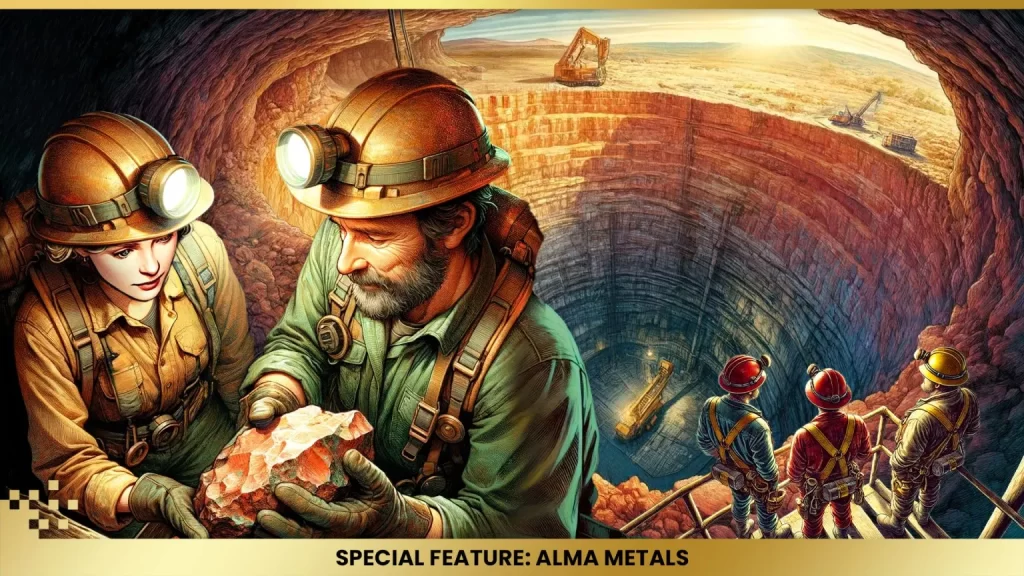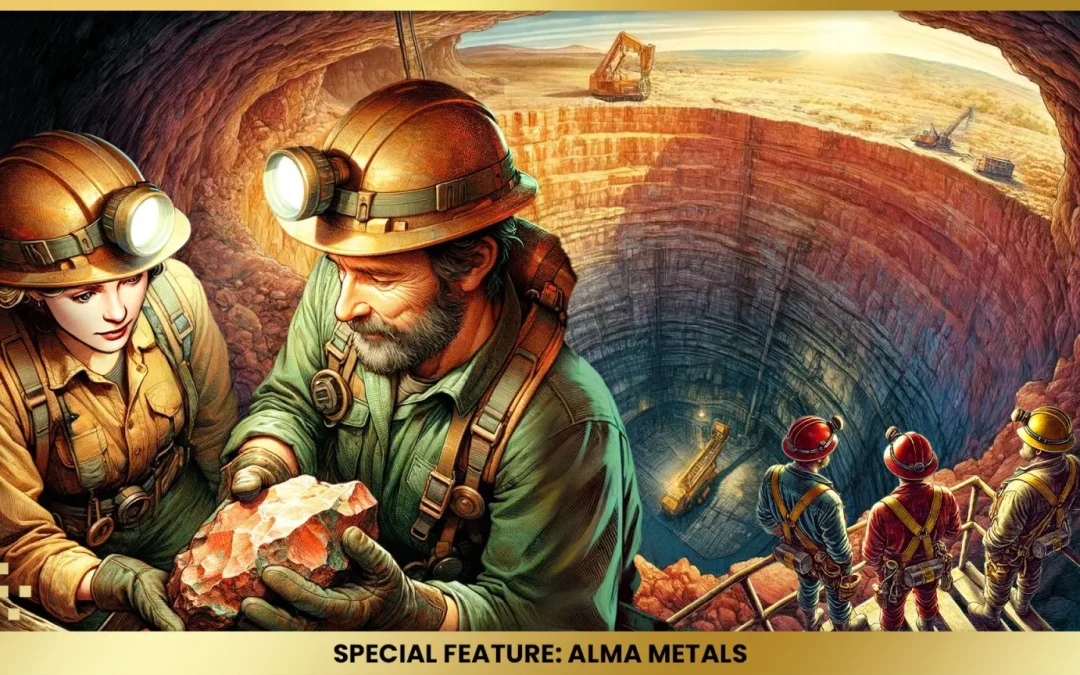

Angela East
Mon, 16 September 2024

Alma Metals: New England Orogen a ‘slow burn’ but big porphyry potential
This article is a sponsored feature from Mining.com.au partner Alma Metals Limited. It is not financial advice. Talk to a registered financial expert before making investment decisions.
Porphyry deposits run deep – from hundreds of metres to several thousands of metres into the Earth. These are massive deposits hosting billions of tonnes worth of the world’s resources.
“Some of the really big ones around the world have got almost 2km of vertical extent,” Frazer Tabeart, Managing Director of copper porphyry hunter Alma Metals, (ASX:ALM) tells Mining.com.au.
Porphyry deposits are the world’s largest source of copper, accounting for over 60% of the red metal, as well as other important metals such as molybdenum, gold and silver. Although low grade, they are extremely high tonnage.
One of the most well-known regions of Australia for these mammoth deposits is the Lachlan Fold Belt in New South Wales, where two of Australia’s largest porphyry deposits – Newmont’s (ASX:NEM) Cadia-Ridgeway and Evolution Mining’s (ASX:EVN) 80% owned Northparkes – reside.
But the region is well picked over, with many explorers securing and investigating a patch of the Lachlan Fold.
By comparison, the New England Orogen – or New England Fold Belt, which sits to the northeast of the Lachlan Fold Belt in New South Wales and continues across the border into Queensland, has just one drill hole for every 13 that has been drilled into the Lachlan.
The most prolific mining period for the New England Orogen was from the 1850s up to World War I. The output during that period would be worth around US$7 billion ($10.41 billion) at today’s prices.
But since then it has not seen the same level of significant exploration investment as the Lachlan Fold Belt.
“The New England Orogen is not as well known for its porphyry copper mineralisation,” Tabeart explains.
Really old rocks
He says the rocks in the Lachlan are much older at around 440 million years-old, known as Silurian age, than those in the New England Orogen.
“What we’re looking at in the New England Fold Belt are 250-million-year-old porphyry systems and whilst they’ve been known for a while, they’ve generally been too low grade to be profitably mined,” Tabeart says.
“So there’s not really been a great deal of mining of porphyry deposits in the New England Orogen.”

Tabeart says Alma’s Briggs Copper Project is probably one of the bigger and better-known porphyry deposits.
“It’s been known for over 60 years, but it’s always been thought to be too low grade,” he says.
“But it’s that combination of copper prices going up and jurisdictional risk in other parts of the world going up that makes things like Briggs and the New England Fold Belt look like they’ll be part of the future of mining in Australia.”
While there is continued volatility in the copper price in the near term, with the London Metal Exchange (LME) price having slipped nearly 18% from its record of over US$10,889 a tonne in May 2024, the longer-term outlook is strong.
LME copper prices are forecast to average about US$9,500 a tonne in 2024, up from US$8,700 a tonne in 2023, rising to US$9,970 a tonne in 2026, according to the Australian Government’s Resources and Energy Quarterly June 2024.
“The world needs more copper as it becomes increasingly reliant on electrification as part of decarbonisation,” Tabeart says.
“So however you look at it, the long-term copper thematic looks really good.”
 Alma also owns the Mannersley deposit located about 10km away from Briggs.
Alma also owns the Mannersley deposit located about 10km away from Briggs.
Tabeart says that while what’s been discovered to date at Mannersley is lower grade and unlikely to be mined, there is certainly potential for other deposits at similar grades to Briggs to emerge as a viable development opportunity.
“And given the infrastructure in New England is pretty good, then those definitely could have a strong future if the copper prices stay where they are and where people are predicting they’ll go,” he notes.
“So it’s a bit of a slow burn, but it’s definitely got that province-scale potential.”
Briggs currently hosts an inferred resource of 415 million tonnes @ 0.25% copper and 31 parts per million molybdenum, for contained resources of 1 million tonnes of copper and over 28.6 million pounds of molybdenum.
Alma has also outlined an exploration target for growing the resource, which envisages the potential to add a further 450 million to 900 million tonnes at similar grades.
The deposit outcrops at surface, with an area measuring 2km long and up to 1km wide mapped out via geology and soil geochemistry, but with less than half that area drilled to date.
Hot copper
Tabeart says a really good way of determining the extent of an at-surface mineralised system is to analyse the copper to zinc ratio.
“In a typical porphyry, your hotter elements are copper, molybdenum, maybe gold if you’ve got it,” he notes.
“They tend to be in the core of the system and as you move out, when you start to get lower temperatures, you’re into the field of stability of things like silver and particularly lead and zinc.”
Tabeart points to Rio Tinto’s (ASX:RIO) Bingham Canyon Mine in Utah, which is one of the world’s largest porphyry systems, as the best example of the copper to zinc ratio.
“You’ve got a copper-moly-gold core which is 3 to 4 billion tonnes, and then up to 3 to 4km away from that you’re into lead-zinc replacement bodies which have been mined. They can be hundreds of millions of tonnes in their own right, and then even further away you get into gold-silver epithermal deposits. They’re some 10km away from the centre of a big system like that,” he says.
“So if you look at that zonation, if you’ve got copper in the core with a zinc low, then a zinc high around it where you’ve got no copper, if you ratio those two together you get an even more enhanced, sharper definition of where the core of the system is.
“It’s a trick the copper porphyry guys use. It’s quite effective and it just seems to work really well here for Briggs.”
Meanwhile, Alma has also only drilled 30 holes at depth, with additional drill holes planned to test the potential further.
Tabeart says there are some drill holes down to depths of about 500m below surface and the mineralisation is still as strong there as it is at surface.
“So there’s every indication that it’s going to extend significantly below 500m. But if we just took the outline of the 500 parts per million copper anomaly in soils and the extent of outcropping mineralisation at surface just down to that 500m, we think there’s another 450-900 million tonnes on top of what we’ve already got,” he explains.
“So you could get a billion tonnes in the top 500m and there’s no evidence that it stops at 500m depth – it’s going to continue below that.
“There’s no doubt it’s going to get bigger. The bottom line is it just needs more drilling.”

